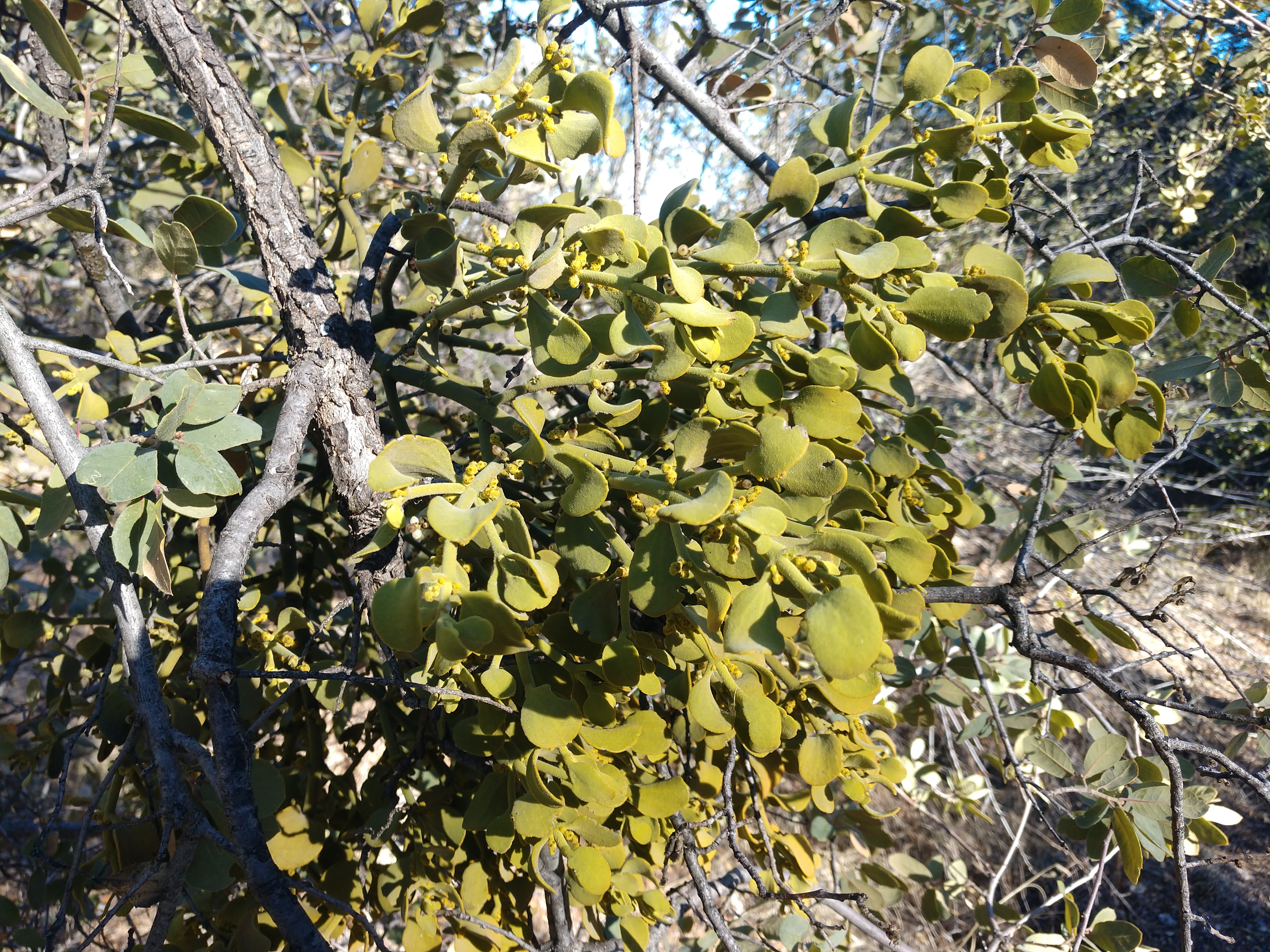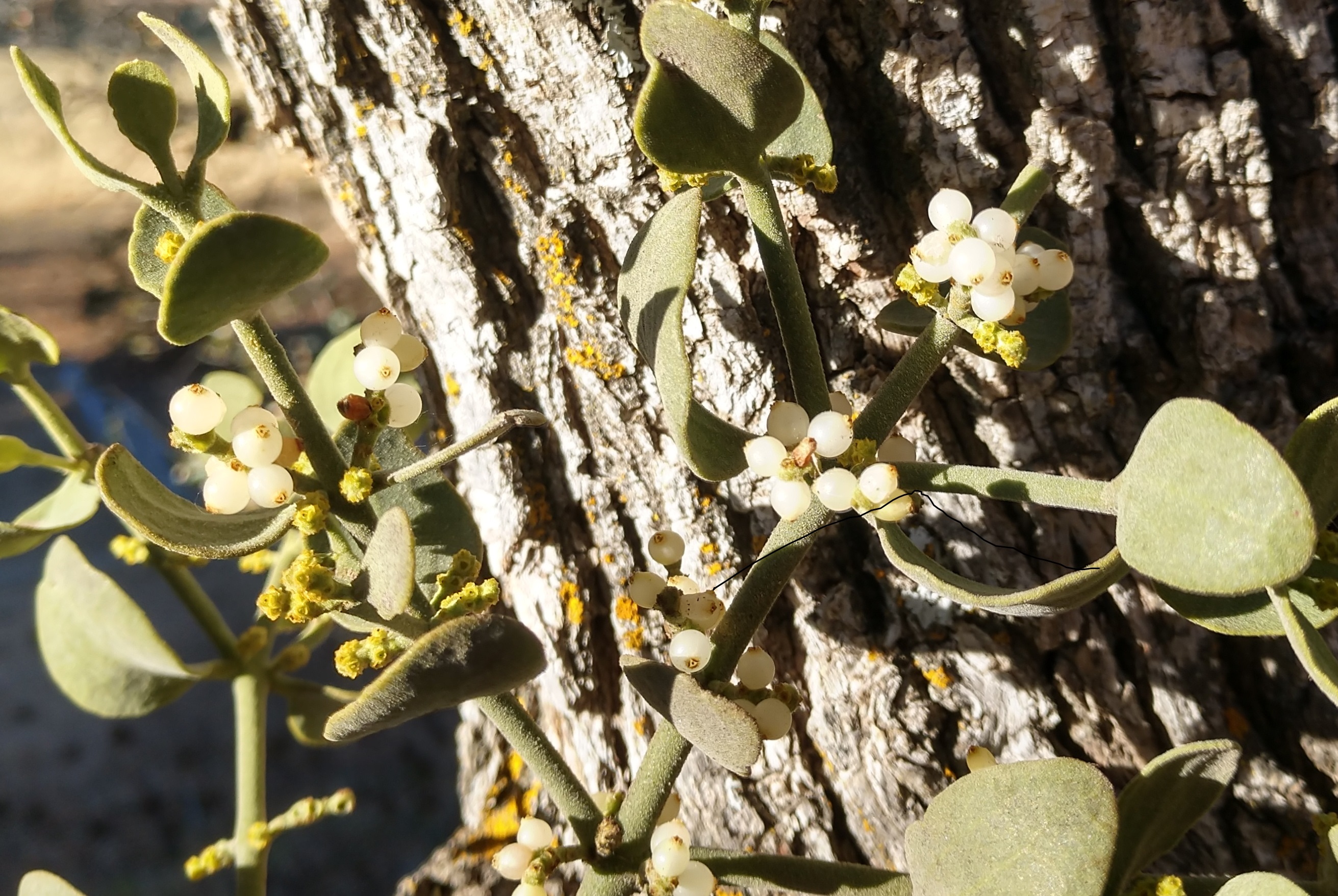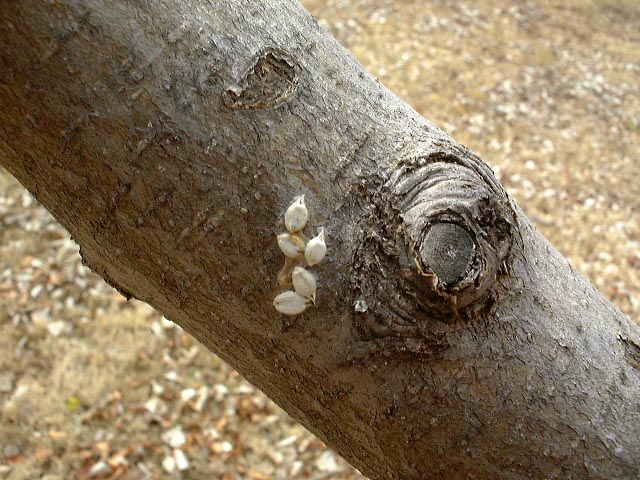 Mistletoe and Folklore - December 25, 2019 Jeff Schalau, Agent, Agriculture & Natural Resources University of Arizona Cooperative Extension, Yavapai County Mistletoes are perennial flowering plants that are parasitic on aboveground portions of woody plants. They have the ability to penetrate a host plant and absorb nutrients. North central Arizona has seven species of true mistletoes and eight species of dwarf mistletoe. True mistletoe (Phoradendron spp.) has green leaves and white berries and is found on a variety of hardwood species, junipers, and cypress. Dwarf mistletoes (Arceuthobium spp.) are leafless and can be yellow, orange, brown, or green. Dwarf mistletoes only affect needle-leafed conifers and are rarely noticed by casual observers. There are several other mistletoe species found around the world. Though most parts of a true mistletoe plant are toxic, the berries are eaten by birds. In Arizona, Phainopeplas (large Flycatchers with red eyes and a feathered crest – males are black and females and immatures are gray) feed on mistletoe berries during winter. Some will simply eat the berry and leave the seed on a branch after wiping its beak. Otherwise, the ingested seeds pass through the digestive tract and are expelled in fecal matter. The seeds remain sticky even after passing through the gut. This bird excrement lands on the branches of trees where the birds have perched. In some cases, the seed is stuck to the bird’s derriere causing it to sit on a branch to rub off the seed. The mistletoe seeds can then germinate, penetrating the host plant and forming root-like structures called haustoria. The origin of the word "mistletoe" appears to come from the Anglo-Saxon words "mistel" which means dung and "tan" for twig. Mistletoe literally translates to "dung-on-a-twig." Probably due to their parasitic nature, elusive method of dispersal, and strange growth habit, many cultures have revered, feared, or thought mistletoes to have magical properties. Mistletoes have had various meanings through history such as: symbols of fertility and romance; aphrodisiacs; bestowers of life; protectants against poisons, witches, or evil spirits; and even plants of peace under which opposing groups can make truces. One source said: the act of kissing under a sprig of mistletoe may date way back to the Greek festival of Saturnalia where it was believed to confer fertility. Druids also utilized mistletoe in sacrificial rituals that increased animal fertility. Exactly where the practice of kissing under the mistletoe started is uncertain, but I found some interesting references. A Scandinavian story referred to Balder, the son of the Norse goddess of love, Frigga who was killed by an arrow of mistletoe. Frigga's tears fell onto the mistletoe and turned into white berries. Frigga swore that mistletoe would never again be a source of death, but instead, should promote love: Anyone caught standing beneath the plant should receive a kiss. There is an old rule that governs kissing under mistletoe that is rarely followed by today’s practitioners. The rule says: a man might steal a kiss under the hanging mistletoe branch, but when he does, one berry must be plucked from the plant and discarded. Once the berries are gone, the kissing charm of the mistletoe branch is spent. Should this rule be updated to allow women to initiate the ritual? I think so. When I was a kid, I harvested mistletoe during the two-week Christmas vacation from school. I remember cruising through the neighborhood on my bike to find the best mistletoe (with lots of berries) on the silver maples trees in the neighborhood. I would climb the tree, haul home my crop, tying red ribbons around little bunches, putting them in baggies, and selling it door-to-door and in front of the local market. At the time, I had no idea that I was selling parasites that originated in bird dung which inspired adults to kiss each other while concurrently increasing fertility and repelling evil. Being serious for a moment, I hope that you have a chance to slow the pace of your life, joyfully celebrate any and all holidays that may apply, and find ways to appreciate the short days and cool temperatures of winter. You can follow the Backyard Gardener on Twitter – use the link on the BYG website. If you have other gardening questions, call or email the Master Gardener help line in the Prescott (928-445-6590/prescottmg@gmail.com) or Camp Verde (928-554-8992/verdevalleymg@gmail.com) and be sure to include your name, address and phone number. Find past Backyard Gardener columns or provide feedback at the Backyard Gardener web site: http://cals.arizona.edu/yavapai/anr/hort/byg/. Images  Mistletoe (Phoradendron flavescens villosum) growing on Arizona white oak (Quercus arizonica) in Prescott, Arizona (Photo by Jeff Schalau, University of Arizona).
Mistletoe (Phoradendron flavescens villosum) growing on Arizona white oak (Quercus arizonica) in Prescott, Arizona (Photo by Jeff Schalau, University of Arizona). Mistletoe (Phoradendron flavescens villosum) berries growing on Arizona white oak (Quercus arizonica) in Prescott, Arizona (Photo by Jeff Schalau, University of Arizona).
Mistletoe (Phoradendron flavescens villosum) berries growing on Arizona white oak (Quercus arizonica) in Prescott, Arizona (Photo by Jeff Schalau, University of Arizona). Mistletoe (Phoradendron flavescens) seeds deposited on an apple tree branch in Cottonwood, Arizona (Photo by Jeff Schalau, University of Arizona).
Mistletoe (Phoradendron flavescens) seeds deposited on an apple tree branch in Cottonwood, Arizona (Photo by Jeff Schalau, University of Arizona).Additional Resources Mistletoe Science and Folklore, MIchigan State University Extension www.canr.msu.edu/news/mistletoe_science_and_folklore True Mistletoes, University of Arizona Cooperative Extension extension.arizona.edu/sites/extension.arizona.edu/files/pubs/az1308.pdf Dwarf Mistletoes, University of Arizona Cooperative Extension extension.arizona.edu/sites/extension.arizona.edu/files/pubs/az1309.pdf |